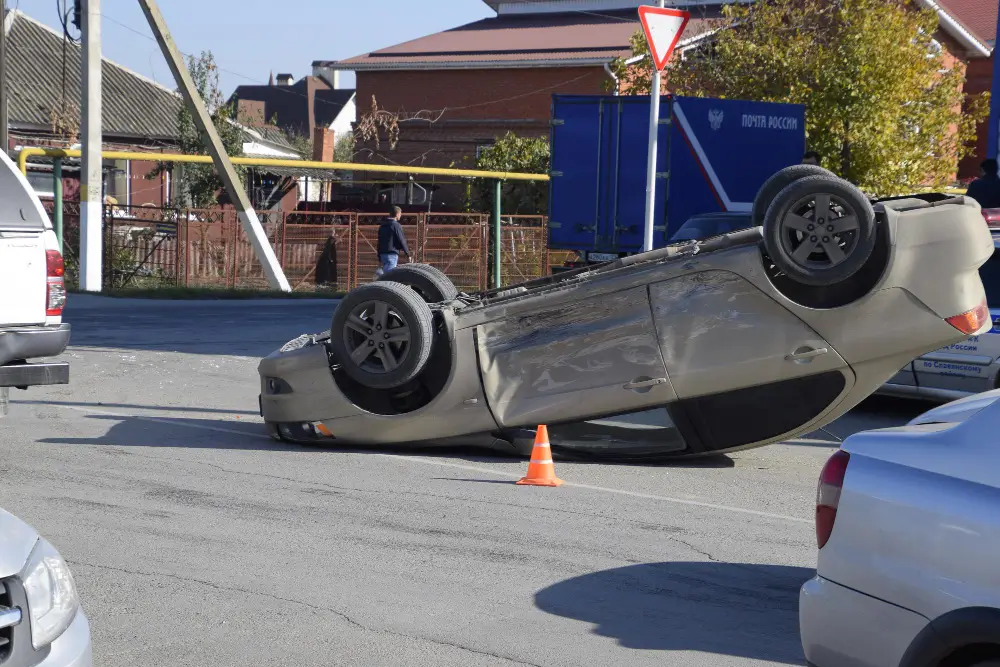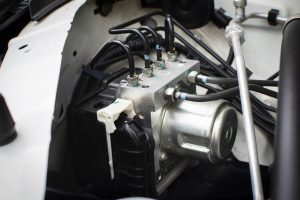A pickup truck flips on its roof after taking a curve too fast on Highway 54. Traffic backs up as drivers call 911, but getting that overturned vehicle upright requires specialized equipment and expertise that goes far beyond standard towing.
Rollover accidents create some of the most challenging recovery situations in the towing industry. At Agile Towing Company Cary, we handle these complex recoveries using professional-grade equipment and proven techniques developed specifically for vehicle uprighting operations. Call us at (919) 276-5900 for emergency rollover accident recovery services.
You’ll learn what causes rollover accidents in Cary, discover the specialized equipment required for safe vehicle uprighting, and understand the step-by-step procedures professionals use to handle these situations. Whether you’re a driver, insurance professional, or fleet manager, this guide provides essential insights into rollover accident recovery operations.
Understanding Rollover Accident Situations in Cary
Rollover accidents don’t happen randomly. They typically result from specific combinations of factors that create the perfect storm for a vehicle to lose stability and flip over.
Common Causes of Rollover Accidents
High-speed turns and highway off-ramps pose significant rollover risks, especially for taller vehicles like SUVs and pickup trucks. Following posted speed limits and understanding driving laws in North Carolina can help reduce these risks. Cary’s highway system includes several challenging curves and interchange ramps where speed and physics can quickly work against drivers. When vehicles take these turns too fast, their center of gravity shifts beyond the tipping point.
Weather conditions play a major role in rollover accident frequency. Rain-slicked roads reduce tire traction, making it easier for vehicles to slide sideways during turns. Ice storms, though less common in Cary, create extremely hazardous conditions where even minor steering inputs can cause loss of control.
Vehicle type significantly influences rollover risk. SUVs, pickup trucks, and vans have higher centers of gravity compared to sedans, making them more susceptible to rolling over during sudden maneuvers or impacts. Commercial delivery vehicles and work trucks face additional risks due to varying load distributions that can shift the center of gravity unpredictably.
Types of Rollover Accident Scenarios
Single vehicle rollovers represent the most common type we encounter in Cary. These typically occur when drivers lose control on curves, attempt sudden lane changes, or overcorrect after drifting off the roadway. The vehicle slides sideways and its tires catch on soft ground or pavement edges, causing it to flip.
Multi-vehicle accidents can include rollover components when initial impacts cause vehicles to spin and become unstable. These situations create more complex recovery challenges because multiple damaged vehicles might be involved, and the rollover vehicle could be pinned or positioned in difficult locations.
Highway median rollovers present unique challenges due to limited access and proximity to high-speed traffic. Recovery teams must work quickly while maintaining safety protocols to protect both operators and passing motorists.
Safety Hazards in Rollover Accident Recovery Operations
Unstable vehicle positioning creates the primary safety concern during rollover accident recovery. Overturned vehicles might appear stable but can shift unexpectedly during recovery operations. Professional assessment determines whether additional stabilization is needed before beginning uprighting procedures.
Fluid leaks from damaged vehicles pose serious safety and environmental risks. Fuel, oil, coolant, and hydraulic fluids can create slippery surfaces and potential fire hazards. Recovery teams must identify and contain these leaks before beginning vehicle manipulation.
Specialized Equipment Required for Rollover Accident Recovery
Standard tow trucks simply cannot handle the complex forces and positioning requirements involved in rollover accident recovery. These situations demand specialized equipment designed specifically for heavy lifting and precise vehicle manipulation.
Heavy-Duty Winches and Cable Systems
Heavy-duty winches form the backbone of rollover accident recovery operations. These systems must generate enough pulling force to lift and rotate vehicles weighing several tons while maintaining control throughout the process. Professional recovery vehicles typically carry winches with capacities ranging from 12,000 to 35,000 pounds, depending on the types of vehicles they regularly recover.
Cable positioning becomes critical for safe and effective vehicle uprighting. Recovery specialists must identify proper attachment points on the overturned vehicle that can handle the stress of lifting without causing additional damage. Multiple attachment points often work together to distribute forces evenly and maintain control during the uprighting process.
The angle of pull significantly affects both the effectiveness and safety of rollover accident recovery operations. Cables positioned at incorrect angles can cause vehicles to slide rather than lift, or worse, can cause uncontrolled rolling that creates additional hazards.
Rotator Tow Trucks and Boom Equipment
Rotator tow trucks represent the gold standard for complex rollover accident recovery. These specialized vehicles feature hydraulic boom systems that can extend, rotate, and lift with precise control. The boom’s reach allows operators to position their truck safely away from the overturned vehicle while still providing the leverage needed for effective recovery.
Hydraulic boom capabilities include multiple degrees of movement that give operators the flexibility to approach rollover accident recovery from optimal angles. These systems can extend horizontally to reach vehicles in difficult positions, then lift vertically to provide the upward force needed for vehicle uprighting.
Stabilization features built into professional recovery vehicles prevent the tow truck itself from becoming unstable during heavy lifting operations. Outriggers, counterweights, and computerized load monitoring systems work together to maintain safe operating conditions throughout the recovery process.
Rigging and Securing Equipment for Rollover Accident Recovery
Specialty chains and straps designed for vehicle recovery provide the connection between recovery equipment and damaged vehicles. These components must withstand enormous forces while protecting vehicle surfaces from additional damage. Recovery specialists select rigging based on the specific requirements of each rollover accident situation.
Protective padding and vehicle protection materials prevent recovery operations from causing additional damage to already compromised vehicles. Soft padding goes between cables and vehicle surfaces, while protective covers shield windows and body panels from debris during the uprighting process.
Professional Rollover Accident Recovery Procedures
How do professional recovery teams safely transform a chaotic rollover accident scene into a controlled recovery operation? The answer lies in systematic procedures that prioritize safety while efficiently clearing roadways.
Scene Assessment and Safety Setup
Professional rollover accident recovery begins with thorough scene assessment. Recovery specialists evaluate vehicle stability, identify potential hazards, and determine the safest approach for uprighting operations. This assessment includes checking for fuel leaks, structural damage, and environmental factors that might affect the recovery process.
Traffic control and scene protection become immediate priorities. Recovery teams coordinate with law enforcement to establish safe work zones that protect both recovery operators and passing motorists. Warning devices, traffic cones, and emergency lighting create visible barriers around the work area.
Recovery Planning and Equipment Positioning
Successful rollover accident recovery requires careful planning before any equipment touches the damaged vehicle. Recovery specialists determine the optimal approach angle, select appropriate attachment points, and position their equipment for maximum effectiveness and safety.
Equipment setup involves more than just parking a tow truck nearby. Professional recovery requires precise positioning that considers factors like ground stability, traffic flow, and potential complications that might arise during the uprighting process. Anchor points might be established using the tow truck’s weight or separate anchoring systems depending on the situation.
Vehicle Uprighting Process in Rollover Accident Recovery
The actual uprighting process happens gradually and under careful control. Recovery operators apply lifting force slowly, monitoring the vehicle’s response and adjusting their approach as needed. Sudden movements can cause additional damage or create safety hazards, so professional recovery emphasizes smooth, controlled operations.
Monitoring for structural damage continues throughout the uprighting process. If the vehicle shows signs of significant structural compromise, recovery specialists may need to modify their approach or take additional precautions to prevent further damage.
Challenges in Rollover Accident Recovery Operations
What makes rollover accident recovery more difficult than standard vehicle towing? Several factors can complicate these operations and require additional expertise and equipment.
Environmental factors significantly affect recovery operations. Soft ground can make it difficult to position equipment safely, while steep slopes or uneven terrain create additional stability challenges. Weather conditions like rain or ice make operations more hazardous and may require modified procedures.
Vehicle condition complications arise when rollover accidents cause severe structural damage. Compromised frames, damaged attachment points, or vehicles with significant cargo loads require specialized handling techniques. Recovery teams must adapt their approach based on each vehicle’s specific condition and damage pattern.
Coordination with emergency responders adds another layer of complexity to rollover accident recovery. Fire departments may need to ensure no fire hazards exist before recovery begins. EMS personnel might need access to check for injured occupants. Police manage traffic control and investigate the accident. Professional recovery teams work within this coordinated response while completing their specialized role efficiently.
Protecting Roads and Drivers Through Professional Rollover Accident Recovery
Rollover accidents test every aspect of professional vehicle recovery capabilities. These challenging situations require specialized equipment, experienced operators, and systematic procedures that prioritize safety while efficiently clearing roadways.
Understanding rollover accident recovery helps drivers, insurance professionals, and transportation managers make informed decisions about emergency service partnerships. Professional recovery protects both the damaged vehicle and everyone involved in the recovery process while minimizing traffic disruption and additional damage.
When rollover accidents occur in Cary, Agile Towing Company Cary provides the specialized expertise your situation demands. Our experienced team understands the unique challenges of rollover accident recovery and maintains the professional-grade equipment necessary for safe, efficient vehicle uprighting. Contact us at (919) 276-5900 to discuss emergency recovery services that protect your interests and get traffic moving safely again.




